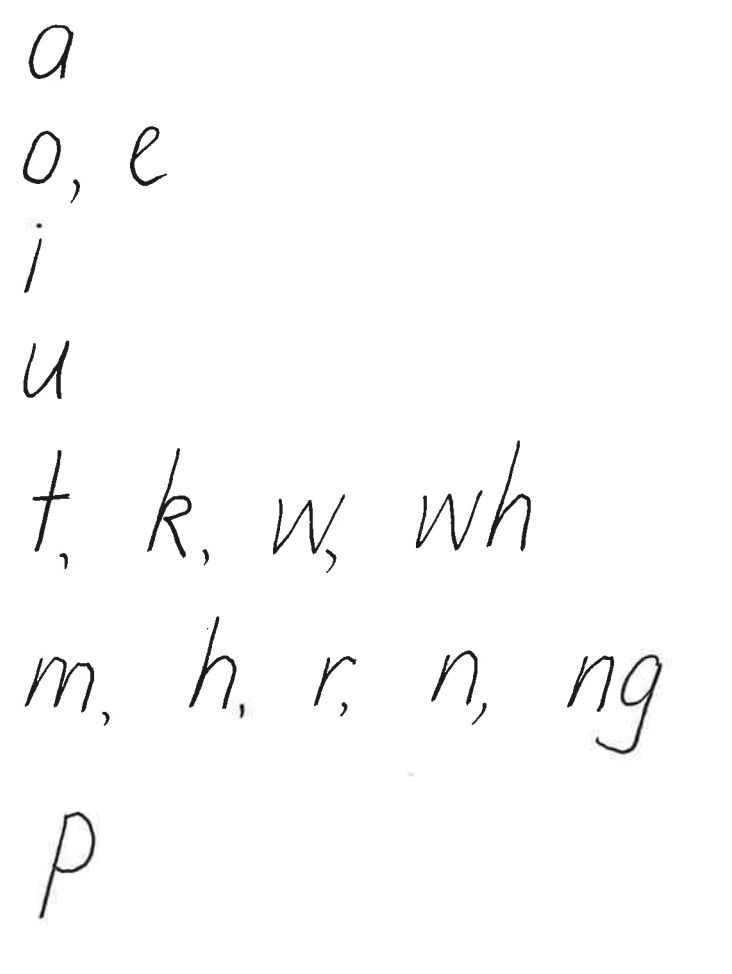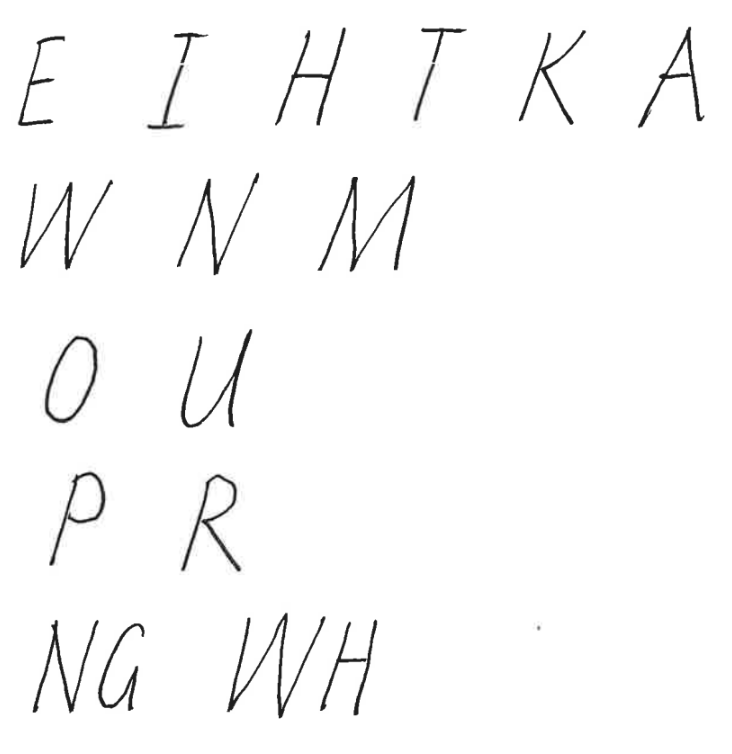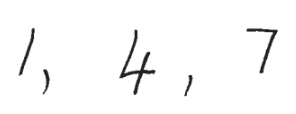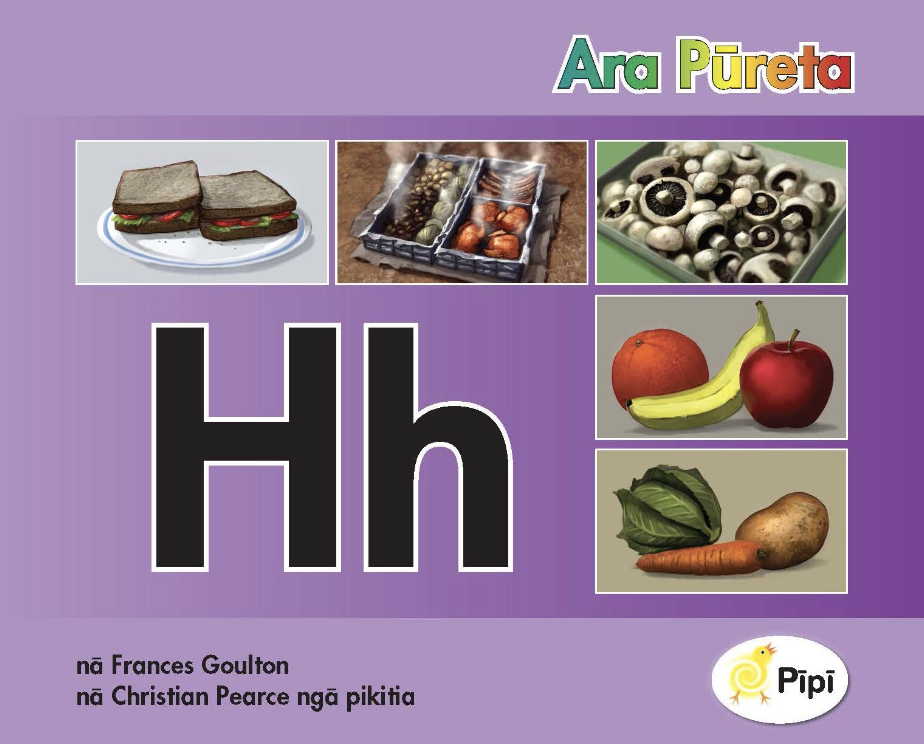I TE TAU TUATAHI
TE WHAKAAKO I TE TUHI Ā-RINGA
I te tau tuatahi: Te Raupapa Whakaako Pū

Use this sequence to ‘teach’ handwriting.
Letters have been grouped according to the movement used to write them correctly. For example t, k, w, and wh are formed using downward straight lines, while, m, h, r, n, ng are formed using a forward arched movement.
NOTE: The 'o' should be shaped as an oval.
I te tau tuatahi: Mai i ngā Pūriki ki ngā Pūmatua
Once ākonga can write most of the lowercase letters accurately and from memory, teach uppercase letters. Letters in the following sequence are grouped according to similarities of movements or orientation. Verbalise the letter formations.

‘W’s are taught with the middle point continuing up to the line and ‘M’ with the middle point continuing down to the line. This makes the letters easier for the ākonga to form because they don’t have to guess the mid-point.
It is recommended that the upper case letters be learnt in context, not in isolation; for example, this can be a teaching point when ākonga are learning to write their names, or are beginning a sentence.
Note: This sequence differs somewhat from the order for teaching the alphabetic principle which is the second element of Rangaranga Reo ā-Tā because the order for the latter is based on different criteria. Handwriting is best practiced separately from the pānui lesson.
I te tau tuatahi: Te Raupapa Whakaako i te Tohutau
In the first year, check for ākonga readiness to practice writing numerals in groups (rather than separately).
Formed with straight lines

Formed with forward curves

Formed with backward curves

Teach letters and numerals in the same time frame but in separate sessions or lessons. Ensure there is a clear distinction between the two sets of symbols, possibly using different contexts or activities for practice.
After the ākonga is able to readily differentiate the letters i, I, t the numeral 1 (tahi) can be introduced with a “select and name” activity. Using numeral and letter cards lay out i and 1 (“Ko te tahi tēnei. Tēhea te tahi? Āe, tēnei te tahi/E hē, kāore te tahi tēnei - tēhea te tahi”). This continues until the ākonga correctly selects and names “tahi” 3 times. The kaiako then lays down the the card and asks the same question. This can be repeated later in the session, later in the day and each day of the week until the kaiako is sure that the knowledge is secure.
I te tau tuatahi: Te Whakaako i te Tuhi ā-Ringa
A typical handwriting lesson includes exercises to practise handwriting movements, instruction in and practice of specific letters, and application of the letters taught.
1) Model the letter or numeral and verbalise the movement. Verbalisation should include where to begin, the direction of the movement, and where to stop. For example, you are teaching the letter ‘h’.
2) As you form the letter on the whiteboard you would say, 'Tīmata i runga, heke iho ki raro, peka atu i te puke, e tū' (Start at the top, go downwards, go over the hill, stop). Do this several times until you have reached the end of your line on the whiteboard. At this point you may decide to choose an ākonga to have a go at forming the letter on the whiteboard in front of the class.
3) The ākonga would all then practise writing the letter in their handwriting books, repeating your verbalisation as they do so.
4) Feedback should be given immediately to ensure ākonga are not reinforcing incorrect forms, particularly when they are first learning to write. Verbalisations are no longer necessary once ākonga know where to start and how to form letters correctly.
5) Walk around the room giving guidance as the ākonga practise the letters. Some ākonga may require the extra support of your hand over theirs as they write so that they can feel the correct movement.
The Ara Pūreta books in the Pīpī pānui series in Tāhūrangi cover the letters of the arapū Māori and aim to familiarise ākonga with the look and sound of each letter and the formation and writing of letters into words.
Each main page contains a letter, a word, and a simple sentence. The shaping of the letter is also supported.
I te tau tuatahi: Te Aromatawai i te Tuhi ā-Ringa
MAHI AROMATAWAI: What to look/listen for ākonga are:
Letter and Numeral Formation
Shape: Look for the correct formation of each letter or numeral, making sure they follow the standard shape and size.
Start and End Points: Check ākonga start and end letters and numerals at the correct points.
Direction: Check that strokes are made in the correct direction (e.g., top to bottom, left to right).
Consistency
Size: Letters and numerals should be consistently sized, with uniform height and width.
Spacing: Observe the spacing between letters.
Line Adherence
Baseline: Letters and numerals should sit on the line with the letters p, and g extending below the line.
Proportion: Ensure that lowercase letters are appropriately proportionate to uppercase letters.
Pressure
Consistency: Check that the pressure applied to the writing instrument is neither too light (resulting in faint writing) nor too heavy (resulting in overly dark writing or tearing the paper).
Evenness: Ensure that the pressure remains consistent throughout.
Legibility
Clarity: Writing should be clear and easily readable.
Accuracy: Letters and numerals should be accurately formed and easily distinguishable.
Attitude and Persistence
Effort: Note ākonga effort and persistence in improving their handwriting.
Attitude: Observe their attitude towards handwriting practice—whether they are engaged and motivated or frustrated and disinterested.

